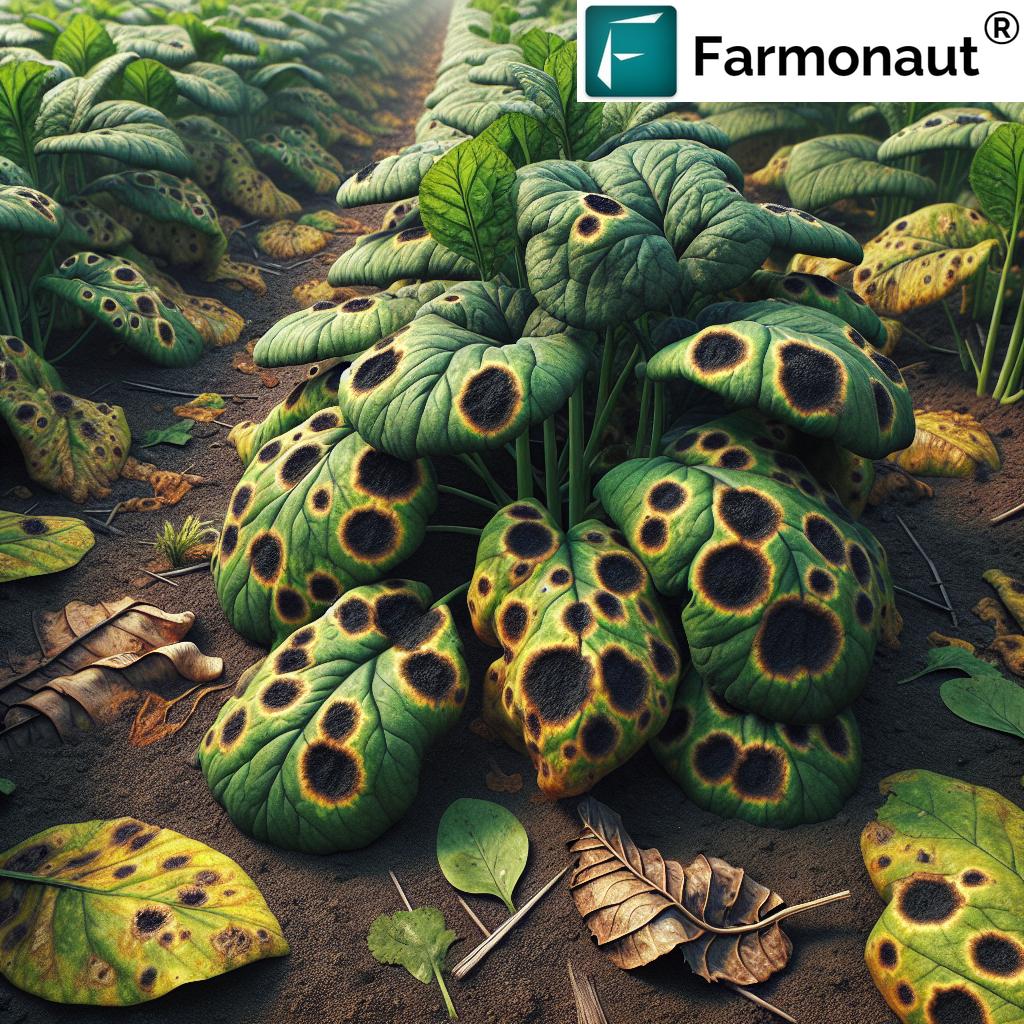Black Spot Fungus: 7 Powerful Strategies to Save Your Crops
Table of Contents
- Introduction
- Etiology and Major Hosts of Black Spot Disease
- Symptoms of Black Spot on Leaves, Fruits, and Tubers
- Epidemiology: Environmental Factors Influencing Black Spot Disease in Plants
- 7 Powerful Strategies for Management of Black Spot in Agriculture
- Comparison Table: Black Spot Disease Management Strategies
- Farmonaut’s Precision Tools for Crop Protection
- FAQ: Black Spot Disease in Plants
- Conclusion
“Black spot fungus can reduce crop yields by up to 50% if not managed promptly and effectively.”
Introduction
Black spot disease in plants is one of the most significant fungal diseases affecting crops and horticultural plants. These diseases manifest as dark lesions on plant tissues, leading to reduced yields, compromised quality, and, in severe cases, plant death. Whether you are an agronomist, commercial farmer, or a hobby gardener, black spot fungus poses an immediate threat to your crop yield and economic returns.
In this comprehensive guide, we’ll uncover the causes, symptoms, epidemiology, and best integrated management of black spot disease in agriculture. You’ll learn seven powerful, science-backed strategies to protect your crops from these devastating pathogens.
Etiology and Major Hosts of Black Spot Disease
Black spot diseases are caused by several distinct fungal species, each adapted to infect particular host plants. The diversity of causative agents, affected crops, and symptoms makes integrated disease management strategies essential for sustainable agriculture and horticulture.
Key Fungal Pathogens and Affected Crops
- Alternaria Black Spot of Canola: Alternaria brassicicola is the culprit here. It principally affects canola (Brassica napus) and other Brassica crops, leading to dark lesions on both leaves and pods. (Learn more)
- Citrus Black Spot: Guignardia citricarpa, induced primarily on citrus fruits, creates black sunken spots on fruit surfaces, making them unmarketable and reducing market quality. (Learn more)
- Black Spot of Roses: Diplocarpon rosae targets ornamental and floricultural crops, causing distinct black spots on rose leaves, often leading to premature defoliation. (Read about rose black spot)
- Black Spot of Grapevines: Elsinoe ampelina infects grapevines and is recognized by dark lesions on leaves and canes. This disease leads to severely reduced yield and fruit quality. (More on grapevine black spot)
- Black Dot Disease of Potatoes: Colletotrichum coccodes causes black dot disease in potatoes, producing black sclerotia on tuber surfaces— damaging both appearance and storability. (See potato black dot)
The presence of dark, circular, or irregular spots on tissues is a universal sign among these diseases, requiring rapid identification for effective management of black spot in agriculture.
Did you know?
Why Is Understanding Etiology Crucial?
Knowing the etiology of black spot facilitates targeted disease control in both agricultural and horticultural crops. For instance, the Alternaria fungus targets canola and specifically exploits environmental stressors in cool, wet climates. Distinguishing among different species and their host plants helps in the selection of resistant varieties and determines which of the 7 strategies will be most effective.
Developers and agricultural scientists can harness real-time crop health data and weather insights for better disease monitoring by integrating Farmonaut’s Crop Monitoring API and accessing our Developer Docs.
“Over 200 plant species are vulnerable to black spot disease, making integrated management crucial for farmers worldwide.”
Symptoms of Black Spot on Leaves, Fruits, and Tubers
The symptoms of black spot diseases are distinct but can vary depending on the host plant and pathogen. Recognizing the early signs ensures swift intervention, which is vital for reducing crop yield loss due to black spot.
Common Manifestations of Black Spot Disease in Plants
- Leaf Lesions: The primary and most observable sign is the appearance of dark, circular spots—sometimes with distinct margins. These spots may be surrounded by yellow halos, particularly on canola, citrus, and roses.
- Premature Defoliation: A strong indicator is the sudden drop of leaves—weakening the plant and reducing its photosynthetic capacity. This is particularly visible in roses, grapevines, and citrus.
- Fruit Blemishes: Fruits, especially citrus and grapevine, may develop black or dark brown lesions, resulting in blemished, unmarketable fruits, significantly affecting quality and retail value.
- Tuber and Cane Symptoms: In potatoes, black dot disease leads to black sclerotia on tuber surfaces. Grapevines exhibit lesions on canes, leading to girdling and cane death.
For example, canola fields in moist regions can suffer yield reductions up to 36% due to pod shatter and decreased seed quality directly linked to Alternaria black spot lesions (Learn about canola black spot).
Leaf, fruit, and tuber symptoms can progress rapidly under favorable environmental conditions, so visual monitoring should be an integral part of your disease management plan.
Broader Impact and Economic Significance
- Compromised Quality: Black spot blemishes downgrade produce grades, reducing returns for farmers and risking loss of premium markets.
- Yield Loss: Unchecked, estructions of up to 50% in yield have been documented on susceptible crops.
- Weakened Plants: Early defoliation and tissue necrosis expose plants to secondary infections and environmental stress damage.
Being able to accurately diagnose the symptoms of black spot on leaves, fruits, and other tissues is a crucial step in integrated disease management strategies.
If you manage large estates or commercial plantations, Farmonaut’s Large Scale Farm Management App provides real-time crop health monitoring, resource optimization, and multi-field analytics—all in one dashboard.
Epidemiology: Environmental Factors Influencing Black Spot Disease in Plants
The development and spread of black spot diseases are highly influenced by environmental factors and the unique epidemiology of each fungal pathogen. By understanding how these factors interact, farmers can implement timely and targeted interventions.
Environmental Conditions That Favor Black Spot Fungus
- Cool, Wet Weather: Black spot diseases flourish in moist, cool environments—typically during spring and early summer. (See grapevine black spot epidemiology)
- High Relative Humidity: Prolonged dew and frequent rainfall create leaf wetness duration, critical for spore germination and fungal penetration.
- Poor Air Circulation: Densely planted crops restrict airflow, raising humidity around leaves and encouraging fungal lesion development.
Sources of Inoculum and Disease Spread
- Overwintering Inoculum: The pathogens often survive in infected plant debris and soil as spores, ready to infect next season’s crop.
- Dissemination: Fungal spores are spread by wind, splash-dispersed rain drops, and (occasionally) insects. This means black spot pathogens can rapidly move within and between fields.
- Infected Planting Material and Tools: The movement of untreated cuttings, tubers, or contaminated pruning shears can introduce the disease to new areas.
These insights demonstrate why cultural practices for disease prevention and constant crop monitoring are so important.
Optimize fleet and machinery operations during crucial disease-prevention activities, such as sanitation and crop scouting, with Farmonaut’s Fleet Management Tools for safer, more efficient agro-logistics.
7 Powerful Strategies for Management of Black Spot in Agriculture
Confronting black spot and other fungal diseases affecting crops requires a multi-pronged, integrated approach. Below are the seven most effective strategies for preventing and controlling black spot disease in plants, reducing crop yield loss, and safeguarding quality.
1. Crop Rotation and Field Sanitation
- Rotate susceptible crops (like canola, potatoes, and brassicas) with non-hosts to disrupt the life cycle of black spot pathogens.
- Remove, compost, or destroy infected plant debris after harvest to reduce sources of overwintering inoculum.
- Weed control is essential, as some weeds can serve as alternative hosts.
Cultural practices for disease prevention form the cornerstone of integrated management.
2. Proper Plant Spacing and Pruning
- Adequate spacing promotes airflow and reduces humidity around foliage, thereby inhibiting fungal development.
- Regular pruning of dense canopies (roses, grapevines) lowers the microclimate humidity, especially after rainfall or irrigation.
- Sanitize pruning tools between plants to minimize the risk of introducing or spreading the infection.
3. Resistant Crop Varieties for Disease Control
- Select cultivars with documented resistance or tolerance to black spot pathogens, where available (e.g., specific grapevine and rose varieties).
- Plant certified, disease-free seeds or cuttings to reduce primary infections.
- Monitor for outbreaks in new or experimental varieties as resistance can sometimes be overcome by pathogen evolution.
Integrating resistant crop varieties for disease control into your production plan reduces reliance on chemical interventions and supports long-term sustainability.
For supply chain managers and exporters, Farmonaut’s Blockchain-Based Product Traceability ensures the authenticity and disease-free status of your produce, adding confidence for buyers and end consumers.
4. Timely Application of Fungicides
- Apply fungicides registered for black spot pathogens as a preventive measure during periods of high risk (wet, cool spells).
- Alternate active ingredients to avoid resistance, and use products as per the recommended label.
- Adopt integrated disease management strategies—fungicides are most effective when combined with cultural controls and monitoring.
Targeted and judicious use of chemical controls can result in over 70% reduction in yield loss when timed appropriately.
Note:
- Always follow applicable regulations and pre-harvest intervals to protect food safety and the environment.
5. Biological Control of Plant Pathogens
- Explore the use of beneficial microbes such as Bacillus amyloliquefaciens that antagonize black spot fungi. (Research on biological controls)
- Integrate with other controls for an eco-friendly approach and to support overall soil health.
6. Monitoring and Early Detection
- Scout fields regularly for the first signs of black spot lesions—especially during weather conducive to the disease.
- Leverage satellite-based crop health platforms (like Farmonaut) to identify stressed zones at scale and deploy targeted interventions.
- Train labor and staff in visual symptom identification and basic sampling techniques.
Early detection can mean the difference between localized incidents and epidemic outbreaks.
Promote sustainable agriculture by tracking your farm’s carbon footprint with Farmonaut. This environmental metric can be critical if black spot management involves increased pesticide use or tillage adjustments, affecting your sustainability goals.
7. Weather-Based Forecasting and Advisory Systems
- Integrate weather forecasts, disease risk alerts, and local environmental data for proactive decision-making.
- Consider platforms with AI-based advisory (like Jeevn AI in Farmonaut) that analyze satellite imagery and climate variables—helping you make timely disease management decisions.
- Automated SMS or app notifications provide frontline staff with the information needed to act quickly during high-risk periods.
Comparison Table: Black Spot Disease Management Strategies
| Strategy Name | Action Step(s) | Est. Effectiveness (% Yield Loss Reduction) | Application Timing | Suitable Crop Types | Cost Estimate (per acre) | Potential Risks |
|---|---|---|---|---|---|---|
| Crop Rotation & Field Sanitation | Rotate with non-hosts, remove infected debris, control weeds | 35–50% | Post-harvest and pre-planting | Canola, Brassicas, Potatoes, Citrus, Grapevines, Roses | Very Low | None if done correctly |
| Proper Spacing & Pruning | Adjust plant spacing, prune to improve airflow | 15–30% | During planting & maintenance | Roses, Grapevines, Citrus | Low | Over-pruning (yield loss risk) |
| Resistant Varieties | Use cultivars with disease resistance traits | Up to 60% | Planting time | Grapevines, Roses, Canola | Medium | Resistance breakdown risk |
| Fungicides (Chemical Control) | Apply registered products preventively, rotate actives | Up to 75% | Before/during high-risk periods | All affected crops | Medium | Resistance, residue concerns |
| Biological Control | Apply beneficial microbes (e.g., Bacillus species) | 30–40% | Early-mid season | Vegetables, Fruits | Medium | Limited by strain/conditions |
| Monitoring & Early Detection | Field scouting, satellite & app-based monitoring | 20–35% (via timely responses) | Throughout season | All crops | Low | Skill/training needed |
| Weather-Based Forecasting | AI/forecast apps, localized warning systems | 10–25% | Per weather alerts | All crops | Low-Medium (app fees) | Dependent on data access |
Reduce economic risk from crop yield loss due to black spot with Farmonaut’s satellite-verified crop loan and insurance solutions. Quick verification, fraud prevention, and access to timely financial help for farmers.
Farmonaut’s Precision Tools for Crop Protection
Farmonaut champions the problem-solving, data-driven approach against black spot disease in plants. By leveraging satellite imagery, AI-based advisories, and blockchain-enabled traceability, our platform streamlines your disease management workflow:
- Real-Time Crop Health Monitoring: Satellite-based NDVI imaging reveals crop stress zones, flagging potential disease outbreaks before symptoms worsen.
- Jeevn AI Advisory System: Personalized, real-time pest and disease management advisories, derived from multi-source data (including weather and remote sensors).
- Blockchain-Based Traceability: Complete, secure record of your crop’s health and management—vital for compliance and premium export markets.
- Fleet/Resource Optimization: Improve the efficiency of field scouting, spraying, and sanitation via fleet tracking.
- Environmental Impact Tracking: Automated carbon footprint metrics let you manage sustainability without complexity.
Our mission is to make precision crop protection affordable and accessible for every farm size, from smallholders to global agribusinesses. You can access Farmonaut’s precision tools via Android, iOS, Web app, and robust API endpoints.
FAQ: Black Spot Disease in Plants
What are the symptoms of black spot on leaves?
Dark, circular or irregular spots with distinct margins—often surrounded by yellow halos. Infected leaves may yellow, wither, and fall off prematurely, weakening the plant.
Which crops are most affected by black spot disease?
Canola, potatoes, brassicas, citrus, grapevines, and roses are the most commonly affected. However, over 200 plant species can succumb to black spot, making integrated management vital.
How does black spot spread within and between fields?
Black spot pathogens spread through wind-blown spores, splash-dispersed rain droplets, movement of infected plant material, and sometimes insects. Overwintering inoculum on debris is a primary source for new infections each season.
What are the most effective management strategies?
An integrated strategy—combining crop rotation, field sanitation, spacing/pruning, use of resistant varieties, targeted fungicide and biological control, plus modern crop monitoring—is the gold standard for effective black spot disease management.
Can I prevent black spot disease without fungicides?
For low-pressure environments or resistant varieties, you may successfully manage black spot using cultural and biological controls, combined with weather-based monitoring and early detection. However, fungicides may be crucial in epidemic situations.
How can remote sensing help in black spot control?
Farmonaut’s satellite imagery tools detect early crop stress and disease symptoms across wide areas, allowing targeted scouting and intervention—saving time, resources, and minimizing crop loss.
What is the impact of black spot on crop quality?
Infected products are often unmarketable due to blemishes, or experience significantly reduced value. Early leaf drop also affects plant vigor and yield.
Conclusion: Protect Crops & Yields from Black Spot Disease
The battle against black spot disease in plants is multifaceted, demanding an informed and integrated approach. By understanding etiology, symptoms, epidemiology, and deploying combined strategies, you can minimize crop yield loss, safeguard quality, and enhance long-term farm viability.
Modern tools—such as those provided by Farmonaut—facilitate real-time detection, precision management, and traceable documentation of interventions. These technological advances, combined with proven cultural and chemical controls, ensure resilient cropping systems against both old and emerging fungal threats.
Act early, monitor consistently, and adopt integrated management—transform these seven strategies from knowledge into action and guarantee a more productive growing season!
Stay informed and secure your crops—start using Farmonaut’s powerful, affordable tools for crop health monitoring and yield protection today!


















